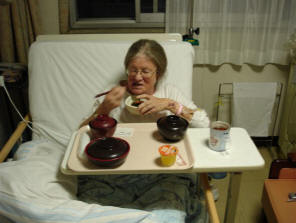Search for dialysis centres here
 Log in to explore the world's most comprehensive database of dialysis centres for free!
Log in to explore the world's most comprehensive database of dialysis centres for free!
| Chopsticks in a Japanese hospital |
 |
 |
 |
| Written by Katy Draper |
|
By Lies Hoekstra, 2006
What was to have been a trip to temples and shrines in Japan, ended in a three day stay in a hospital bed in Tokyo and a stretcher ride home on an airplane. There I am on a trolley in the A&E in Kosei hospital in Tokyo: my shin a mess of blood after my thin prednisone skin came into contact with a bus step. I have a letter from my doctor in Holland, stating my various illnesses (kidney transplant, diabetes) and I am very lucky to have some really nice interpreters to translate it (more or less). Two doctors come in: no names, no handshake: straight to the business in hand. One of them (he turns out to be a plastic surgeon), looks worried: it is going to be a long affair. So I want to get home as soon as possible. Communication (when the interpreters are not available) is with hands and feet and a small Japanese dictionary. No complaints about the treatment: anti-tetanus, and antibiotics and the dressings are changed every day. My temperature, blood pressure and pulse are checked three times a day and I am allowed to administer my own medicines, even the daily insulin injection. The nurses greet you with folded hands every time they come in. This becomes such a habit that I catch myself greeting the stewardess on the plane that way on the ride home. Arigato: thank you, that is the most important word to know. I can also do good morning, good evening and please. The next important word to master is: may I use the toilet please. And I have to make sure to use the right word for the female facility. It would be extremely rude to ask for the other one. The toilet in the room comes out off the wall and disappears again after use. The stay in the hospital resembles caravanning: there is my bed and a cot for my 34 year old daughter. She, however, is not of Japanese size (being 6 feet), so the cot is made longer, and then it is no longer possible to close the door to the hall. I have been to Japan, Korea and Taiwan, so I can manage chopsticks, even in a hospital bed. Corn and peas present no problem, but jelly is more difficult! Food is beautifully presented in individual bowls and I like it. However, it is difficult to get up an appetite when all you do is lie in bed. This worries the nurses: don't I like Japanese food? The next morning there is toast for breakfast, with butter, but no utensil to spread it with . On my last morning there even is a fried egg. I do love the crackers and cheese on the plane home however. Good insurance with the AA secures me a place on a stretcher after three days. I am very glad to have my competent travel wise daughter with me to manage Internet and cell phones. |
 Professional dialysis recruitment
Professional dialysis recruitment

